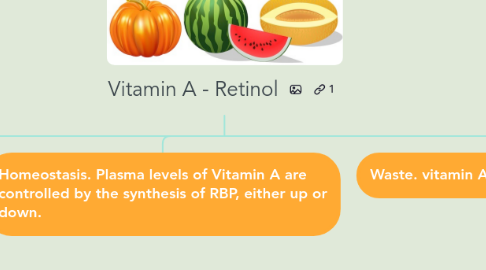
1. Deficiency
1.1. Immunity
1.1.1. Severe vitamin A deficiency predisposes the individual to infection because of decreased - mucus secretion Cell- mediated immunity antibodies
1.1.2. Imbalance in Th1 and Th2 responses (inflammatory & anti-inflammatory cytokines)
1.1.3. Inadequate immune regulation - e.g. T helper cell differentiation & activation, regulation of T-regs
1.1.4. Weak response to vaccines
1.2. Leaky Gut
1.2.1. Deficiency of vitamin A leads to a reduction in the mucous secreting cells which coat the tissues in the gut and protects them from invasive microorganisms and other harmful particles which could lead to gut irritation and inflammation.
1.3. Causes
1.3.1. Alcohol inhibits conversion of retinol to retinal due to alcohol dehydrogenase and retinol hydrogenase being virtually identical.
1.3.2. A vegan diet
1.3.3. Malabsorption
1.3.4. Low fat diet
1.4. Eyes
1.4.1. Prolonged deficiency leads to Xerophthalmia
1.4.1.1. ‘night blindness’ - loss of ability to adapt to dim light caused by lack of vitamin A in the retina
1.4.2. Lack of vitamin A in the cornea and conjunctiva can lead to:
1.4.2.1. Bitot’s spots: white deposits on conjunctiva
1.4.2.2. Corneal Xerosis (drying and hardening of cornea) The cornea becomes dry because glands in the conjunctiva no longer function normally. This leads to loss of tears and also loss of mucous, which acts as a ‘wetting agent’. Increases the risk of infection.
1.4.2.3. Corneal ulceration • If the acute vitamin A deficiency is not reversed quickly, the cornea can become ulcerated and melt away. The ulcer may have the appearance of a small, punched-out area in the cornea or the ulcer may have a fluffier appearance. Secondary infection of the ulcer is common, leading to an acutely inflamed eye.
1.4.2.4. Keratomalacia (softening of cornea, reversible) - the most severe form of xerophthalmia in which more than 1/3 of the cornea is affected. - The cornea may become oedematous and thickened, and then melt away. • The structure of the collagen in the cornea is affected by necrosis. • The cornea can be destroyed in just a few days.
1.4.2.4.1. Causes - malnourishment or following measles infection (depletion of vitamin A stores)
1.4.3. The retinol is oxidized to its aldehyde, retinal, which complexes with a molecule in the eye called opsin. When a photon of light hits the complex, the retinal changes from the 11-cis form to the all-trans form, initiating a chain of events which results in the transmission of an impulse up the optic nerve
1.5. Skin
1.5.1. Epithelial - skin tags horny plugs and blocked sebaceous glands
2. Sources
2.1. Found in animal sources; liver, dairy, eggs and fish
2.2. Also in carrots, kale, papaya, peppers, spinach and tomatoes
3. Main Functions
3.1. Necessary for Bone Metabolism
3.2. Cellular differentiation and growth, helps to maintain function and structure of epithelial cells.
3.3. All mucous membranes
3.4. Skin Health
3.4.1. Vitamin A helps maintains the normal structure and function of epithelial cells and controls the keratinocyte growth
3.4.2. Acne - reduces sebum production but suppressing the gene responsible for its synthesis
3.4.3. Eczema and psoriasis - has anti inflammatory effects, normalises proliferation of epithelia and modulates immunity in skin.
3.5. Eyes
3.5.1. Needed for the production of Rhodopsin in the retinal rods in the eye that adapt to vision in the dark, growth, cell differentiation, embryogenesis
3.5.2. Important role in night vision
3.6. Immunity
3.6.1. Maintains mucosal integrity
3.6.2. Strong anti-viral activity
3.6.3. Involved in T cell maturation, differentiation and proliferation
3.6.4. synthesis of glycoproteins
3.7. Reproduction
3.7.1. Important role in cell growth in embryogenesis
3.7.2. Critical for spermatogenesis
3.7.3. Involved in testosterone and oestrogen production
4. Dosing
4.1. RNI
4.1.1. F - 800mcg M - 1000mcg
4.2. SUL
4.2.1. 1500mcg approx
4.3. Acute toxicity (33300iu) will produce abdominal pain, vomiting, headaches
4.4. Chronic toxicity (50000iu) over a period of weeks months or years, will cause hair loss, bone loss, joint pain, dry thick skin, cracking of the lips.
4.4.1. Vitamin A is teratogenic: • Advised NOT to supplement during pregnancy - can cause toxic and teratogenic effects in the embryo and foetus, especially in the first trimester of human pregnancy.
5. Transport. Vitamin A is transported via chylomicrons and retinol binding protein (RBP) which transports it from the liver to tissues
5.1. Zinc is required for the synthesis of RBP
5.2. and protein
6. Homeostasis. Plasma levels of Vitamin A are controlled by the synthesis of RBP, either up or down.
7. Waste. vitamin A is excreted via bile and faeces
8. Interactions
8.1. It's also involved in erythropoietin synthesis so is involved in iron storage and could effect RBC synthesis
8.2. Iron
8.2.1. Vitamin A may affect iron mobilization from tissues rather than iron absorption
8.2.2. Vitamin A modulates erythropoietin synthesis and may influence iron storage and mobilisation
8.2.3. Vitamin A deficiency impairs the utilisation of Fe for Hb synthesis, in part by trapping Fe in the liver and spleen
